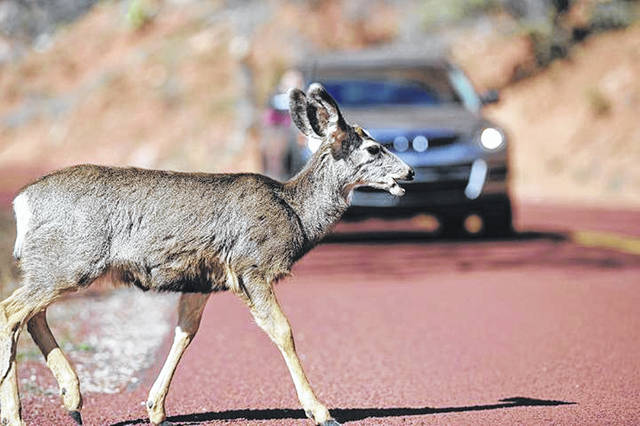
DAYTON – Fall is officially here and AAA is warning drivers to be more cautious on the roads. Deer mating season is right around the corner and October, November and December are the months for the most motor vehicle collisions with animals. A collision with a deer or other animal can put a serious dent in a vehicle, if not destroy it, and could result in serious injuries or fatalities.
“Animal-vehicle collisions start to increase in October and peak in mid-November,” said Kara Hitchens, AAA spokesperson. “For that reason, motorists need to be even more cautious and alert behind the wheel, especially at dawn and dusk, which can be the times for high levels of deer activity.”
Champaign County had 49 deer strikes in 2018, according to AAA Miami Valley, which reports the following number in other AAA Miami Valley counties: Clark, 204; Darke, 202; Greene, 325; Miami, 259, Montgomery, 215; Preble, 124.
2018 data from the Ohio Department of Transportation, show 18,302 deer collision crashes reported in Ohio with the majority of crashes occurring during October, November and December. Although striking a deer during this season is common, drivers swerving in an attempt to miss a deer is another common cause for crashes. This can be a fatal mistake because the driver may hit an oncoming motorist head-on.
“Deer and other animals can be unpredictable and might dash out in front of your vehicle. But there are actions you can take to help prevent a crash or reduce the damage from an animal collision,” said Hitchens. “First and foremost, drivers and passengers should always wear a seat belt and take steps to avoid distractions behind the wheel.”
A costly crash
While any animal on the road can be dangerous, the Insurance Institute of Highway Safety says there are more than 1.5 million deer-vehicle collisions each year, resulting in 150 human deaths and tens of thousands of injuries. Crashes involving deer can pose great risk to motorists, but even a crash in which no one is injured can be costly. AAA Insurance reports the average cost per deer-related claim in Ohio in 2018 was nearly $4,000.
The National Insurance Crime Bureau finds that between 2014 and 2017 there were 1,740,425 animal-related insurance claims processed in the United States, with collisions with deer causing the most claims. The actual number of incidents is likely much higher since many drivers do not choose to carry coverage for this type of event. Collision coverage pays for damage to vehicles resulting from a collision with an object (e.g., a telephone pole, a guard rail, a mailbox), or as a result of flipping over. Comprehensive coverage is for damage to vehicles covered by disasters “other than collisions,” contacts (in this case, contact/collision with animals) and are paid for under the comprehensive portion of an auto insurance policy.
In the event of a collision
In the event of a collision with an animal, AAA recommends:
– Following the collision, call the police.
– Avoid making contact with the deer/animal. A frightened or wounded animal can be dangerous and pose a threat when approached or may further injure itself.
– Activate the vehicle’s hazard lights whether it’s light or dark outside.
– If possible, move the vehicle to a safe location, off the roadway, and wait for help to arrive.
– AAA recommends that drivers contact their insurance agent or company representative as quickly as possible to report any vehicle damage. Collision with a deer or other animals is covered under the comprehensive portion of automobile policies.
Avoiding crashes
AAA offers these tips to help drivers avoid a crash or possibly reduce damage caused by vehicle/animal collisions:
– Pay attention to road signs. Yellow, diamond-shaped signs with an image of a deer indicate areas with high levels of deer activity.
– Continually scan roadways. Drivers should continuously sweep their eyes across the road in front of the vehicle looking for signs of animals and movement. Animals may also travel alongside the road, so make sure to look along both sides of the roadway, as well. While the most likely crash happens when drivers strike an animal, on occasion the animal may run into the vehicle.
– Be especially attentive in early morning and evening hours. Many wild animals, especially deer, are most active 5-8 a.m. and 5-8 p.m. – prime commuting times for many people.
– Use high beams when there’s no oncoming traffic to spot animals sooner. Sometimes the light reflecting off their eyes will reveal their location.
– Slow down, and watch for other deer to appear. Deer rarely travel alone, so if drivers see one, there are likely more.
– Slow down around curves. It’s harder to spot animals when going around curves.
– A long blast of a horn may frighten animals away from the vehicle.
– Resist the urge to swerve: Instead, drivers need to concentrate on keeping the vehicle in the marked lanes of travel with both hands firmly on the wheel. Swerving away from animals may place drivers in the path of oncoming vehicles or result in a crash with something along the roadway like a lamppost or a tree.
If a crash is imminent
If a deer collision is imminent, take your foot off the brake. During hard braking, the front end of the vehicle is pulled downward which can cause the animal to travel up over the hood toward the windshield. Letting off the brake can protect drivers from windshield strikes because the animal is more likely to be pushed to one side of the vehicle or over the top of the vehicle.
Always wear a seat belt. Also never drive impaired, distracted or drowsy.


